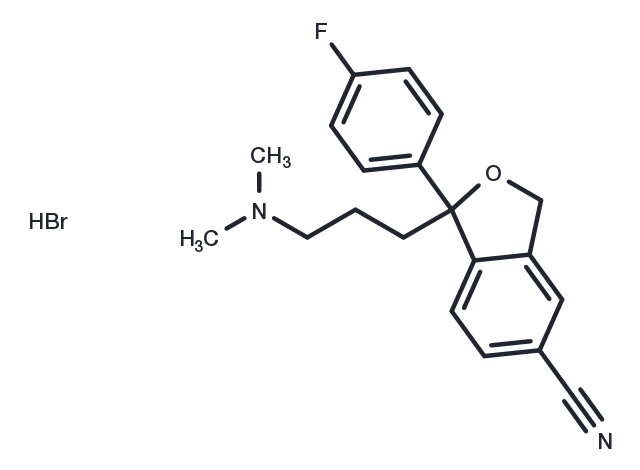Powder: -20°C for 3 years | In solvent: -80°C for 1 year


Citalopram hydrobromide (XU-62-320) , a selective serotonin reuptake inhibitor (SSRI), selectively inhibits the CNS neuronal reuptake of serotonin, thereby potentiating serotonergic activity in the central nervous system (CNS). Citalopram hydrobromide is the orally bioavailable hydrobromide salt of the racemic bicyclic phthalene derivative citalopram with antidepressant activity. This agent has minimal effects on the CNS neuronal reuptake of norepinephrine (NE) and dopamine (DA).

| Pack Size | Availability | Price/USD | Quantity |
|---|---|---|---|
| 10 mg | In stock | $ 40.00 | |
| 25 mg | In stock | $ 65.00 | |
| 50 mg | In stock | $ 82.00 | |
| 100 mg | In stock | $ 112.00 | |
| 200 mg | In stock | $ 157.00 | |
| 500 mg | In stock | $ 259.00 |


| Description | Citalopram hydrobromide (XU-62-320) , a selective serotonin reuptake inhibitor (SSRI), selectively inhibits the CNS neuronal reuptake of serotonin, thereby potentiating serotonergic activity in the central nervous system (CNS). Citalopram hydrobromide is the orally bioavailable hydrobromide salt of the racemic bicyclic phthalene derivative citalopram with antidepressant activity. This agent has minimal effects on the CNS neuronal reuptake of norepinephrine (NE) and dopamine (DA). |
| Targets&IC50 | 5-HT receptor:1.8 nM |
| In vitro | Citalopram (Lu 10-171), a new bicyclic phthalane derivative, is an extremely potent inhibitor of neuronal serotonin (5-HT) uptake but has no effect on the uptake of noradrenaline(NA) and dopamine (DA) and no antagonistic activity towards 5-HT, histamine, gamma aminobutyric acid (GABA), acetylcholine, and morphine receptors. It is an extremely specific and potent inhibitor of neuronal 5-HT uptake. Uptake mechanisms for other transmitter amines are not influenced by the drug[1]. The SSRI citalopram has a greater effect on proliferation and a lesser effect on apoptotic activity. It affects cell cycle regulation by increasing proliferative potential and decreasing apoptotic activity in a site specific manner that may be indicative of hyperplasia. Citalopram alters FGF, MSX and TGFB expression in osteoblast cell culture[3]. |
| In vivo | Citalopram is devoid of cardiotoxic effects even when animals are exposed to concentrations far above the therapeutic level. In man citalopram is metabolized to compounds which are also potent 5-HT-uptake inhibitors without effect on noradrenaline(NA) uptake and which are found in lower concentrations than citalopram itself. Citalopram (1-16 mg/kg) stimulates the hind limb flexor reflex in the spinal rat. Citalopram potentiates 5-HT transmission~ possibly by producing very strong uptake inhibition without simultaneously blocking the post-synaptic 5-HT receptors[1]. |
| Cell Research | Cells are cultured in alpha minimum Eagles medium supplemented with 1% penicillin/streptomycin, 10% fetal bovine serum and Amphotericin B. For control data, cells are cultured for 3 or 7 days with standard alpha proliferation media. For SSRI treatments, media is supplemented with citalopram eluted to serially diluted doses between 10?4 mol through 10?10 mol to achieve a dose response curve.(Only for Reference) |
| Synonyms | Lu 10-171, Nitalapram HBr, Bonitrile HBr, XU-62-320, Lu 10-171 HBr, Citalopram HBr |
| Molecular Weight | 405.304 |
| Formula | C20H22BrFN2O |
| CAS No. | 59729-32-7 |
Powder: -20°C for 3 years | In solvent: -80°C for 1 year
Ethanol: 6 mg/mL(14.8 mM)
H2O: 4 mg/mL(9.9 mM)
You can also refer to dose conversion for different animals. More
bottom
Please see Inhibitor Handling Instructions for more frequently ask questions. Topics include: how to prepare stock solutions, how to store products, and cautions on cell-based assays & animal experiments, etc.
Citalopram hydrobromide 59729-32-7 Autophagy GPCR/G Protein Neuroscience 5-HT Receptor Serotonin Transporter Citalopram SLC6A4 Lu 10-171 SERT serotonin Nitalapram HBr selective 5-HTT 5-HT,Antidepressant Bonitrile HBr (±)-Citalopram XU-62-320 Citalopram Hydrobromide reuptake Lu 10-171 HBr inhibitor inhibit SSRI Citalopram HBr
